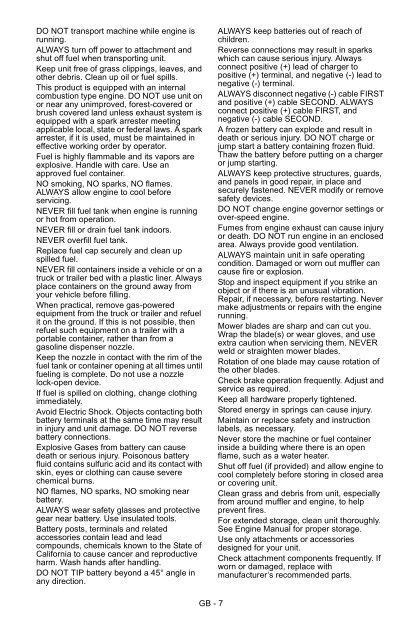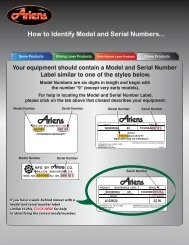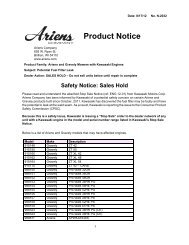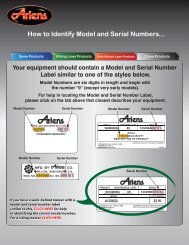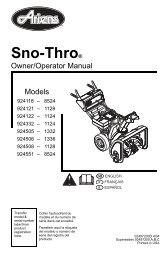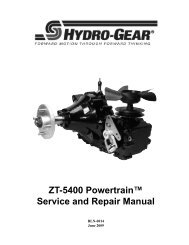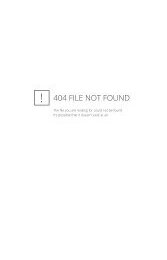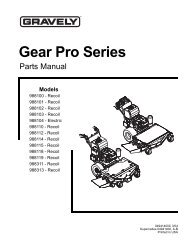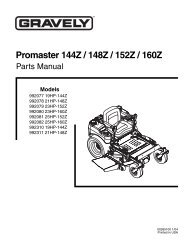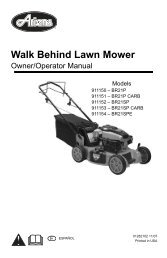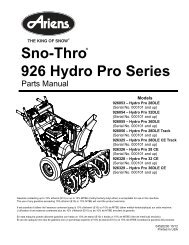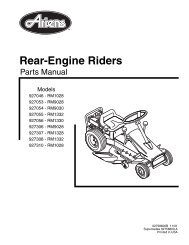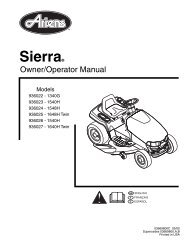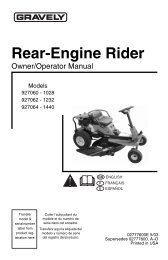Create successful ePaper yourself
Turn your PDF publications into a flip-book with our unique Google optimized e-Paper software.
DO NOT transport machine while engine is<br />
running.<br />
ALWAYS turn off power to attachment and<br />
shut off fuel when transporting unit.<br />
Keep unit free of grass clippings, leaves, and<br />
other debris. Clean up oil or fuel spills.<br />
This product is equipped with an internal<br />
combustion type engine. DO NOT use unit on<br />
or near any unimproved, forest-covered or<br />
brush covered land unless exhaust system is<br />
equipped with a spark arrester meeting<br />
applicable local, state or federal laws. A spark<br />
arrester, if it is used, must be maintained in<br />
effective working order by operator.<br />
Fuel is highly flammable and its vapors are<br />
explosive. Handle with care. Use an<br />
approved fuel container.<br />
NO smoking, NO sparks, NO flames.<br />
ALWAYS allow engine to cool before<br />
servicing.<br />
NEVER fill fuel tank when engine is running<br />
or hot from operation.<br />
NEVER fill or drain fuel tank indoors.<br />
NEVER overfill fuel tank.<br />
Replace fuel cap securely and clean up<br />
spilled fuel.<br />
NEVER fill containers inside a vehicle or on a<br />
truck or trailer bed with a plastic liner. Always<br />
place containers on the ground away from<br />
your vehicle before filling.<br />
When practical, remove gas-powered<br />
equipment from the truck or trailer and refuel<br />
it on the ground. If this is not possible, then<br />
refuel such equipment on a trailer with a<br />
portable container, rather than from a<br />
gasoline dispenser nozzle.<br />
Keep the nozzle in contact with the rim of the<br />
fuel tank or container opening at all times until<br />
fueling is complete. Do not use a nozzle<br />
lock-open device.<br />
If fuel is spilled on clothing, change clothing<br />
immediately.<br />
Avoid Electric Shock. Objects contacting both<br />
battery terminals at the same time may result<br />
in injury and unit damage. DO NOT reverse<br />
battery connections.<br />
Explosive Gases from battery can cause<br />
death or serious injury. Poisonous battery<br />
fluid contains sulfuric acid and its contact with<br />
skin, eyes or clothing can cause severe<br />
chemical burns.<br />
NO flames, NO sparks, NO smoking near<br />
battery.<br />
ALWAYS wear safety glasses and protective<br />
gear near battery. Use insulated tools.<br />
Battery posts, terminals and related<br />
accessories contain lead and lead<br />
compounds, chemicals known to the State of<br />
California to cause cancer and reproductive<br />
harm. Wash hands after handling.<br />
DO NOT TIP battery beyond a 45° angle in<br />
any direction.<br />
ALWAYS keep batteries out of reach of<br />
children.<br />
Reverse connections may result in sparks<br />
which can cause serious injury. Always<br />
connect positive (+) lead of charger to<br />
positive (+) terminal, and negative (-) lead to<br />
negative (-) terminal.<br />
ALWAYS disconnect negative (-) cable FIRST<br />
and positive (+) cable SECOND. ALWAYS<br />
connect positive (+) cable FIRST, and<br />
negative (-) cable SECOND.<br />
A frozen battery can explode and result in<br />
death or serious injury. DO NOT charge or<br />
jump start a battery containing frozen fluid.<br />
Thaw the battery before putting on a charger<br />
or jump starting.<br />
ALWAYS keep protective structures, guards,<br />
and panels in good repair, in place and<br />
securely fastened. NEVER modify or remove<br />
safety devices.<br />
DO NOT change engine governor settings or<br />
over-speed engine.<br />
Fumes from engine exhaust can cause injury<br />
or death. DO NOT run engine in an enclosed<br />
area. Always provide good ventilation.<br />
ALWAYS maintain unit in safe operating<br />
condition. Damaged or worn out muffler can<br />
cause fire or explosion.<br />
Stop and inspect equipment if you strike an<br />
object or if there is an unusual vibration.<br />
Repair, if necessary, before restarting. Never<br />
make adjustments or repairs with the engine<br />
running.<br />
Mower blades are sharp and can cut you.<br />
Wrap the blade(s) or wear gloves, and use<br />
extra caution when servicing them. NEVER<br />
weld or straighten mower blades.<br />
Rotation of one blade may cause rotation of<br />
the other blades.<br />
Check brake operation frequently. Adjust and<br />
service as required.<br />
Keep all hardware properly tightened.<br />
Stored energy in springs can cause injury.<br />
Maintain or replace safety and instruction<br />
labels, as necessary.<br />
Never store the machine or fuel container<br />
inside a building where there is an open<br />
flame, such as a water heater.<br />
Shut off fuel (if provided) and allow engine to<br />
cool completely before storing in closed area<br />
or covering unit.<br />
Clean grass and debris from unit, especially<br />
from around muffler and engine, to help<br />
prevent fires.<br />
For extended storage, clean unit thoroughly.<br />
See Engine <strong>Manual</strong> for proper storage.<br />
Use only attachments or accessories<br />
designed for your unit.<br />
Check attachment components frequently. If<br />
worn or damaged, replace with<br />
manufacturer’s recommended parts.<br />
GB - 7


